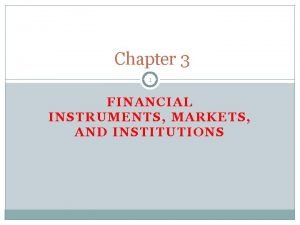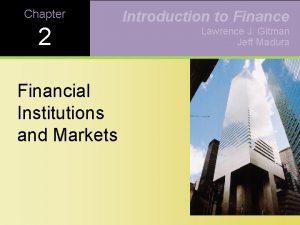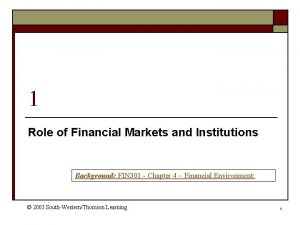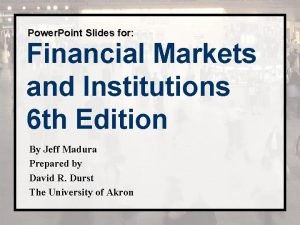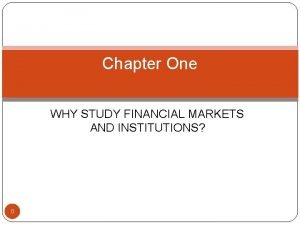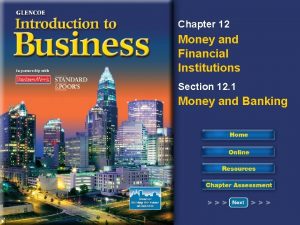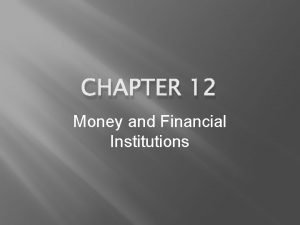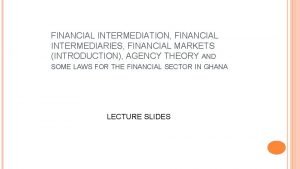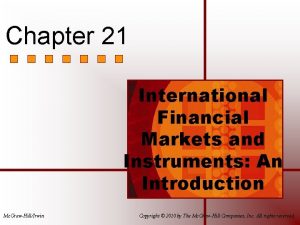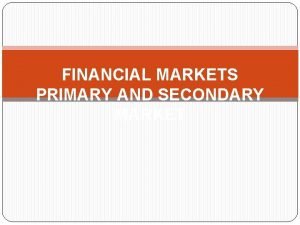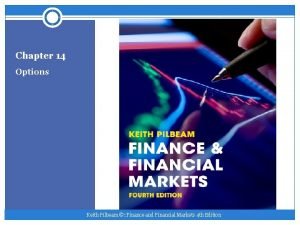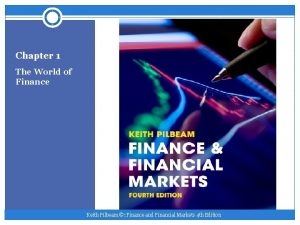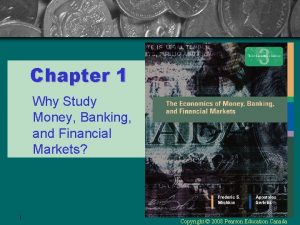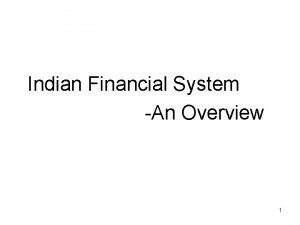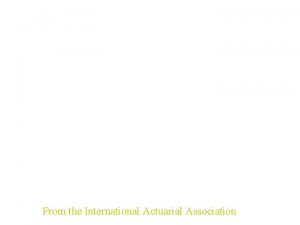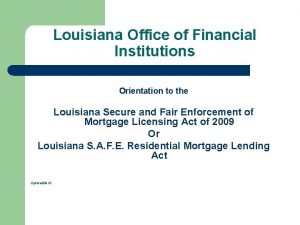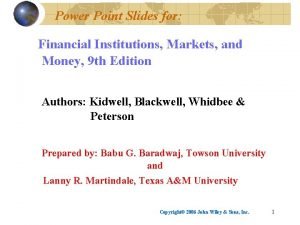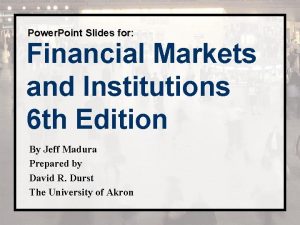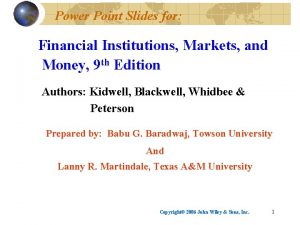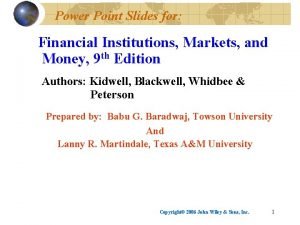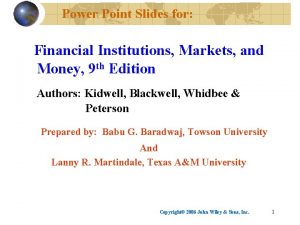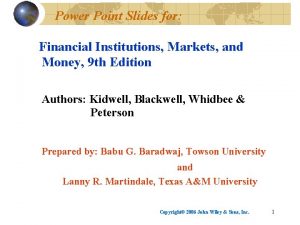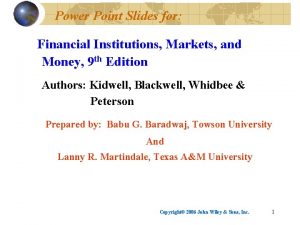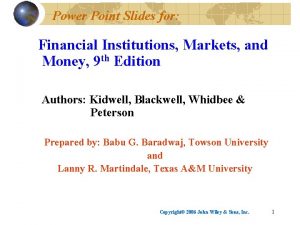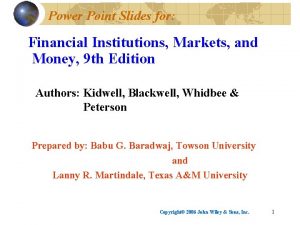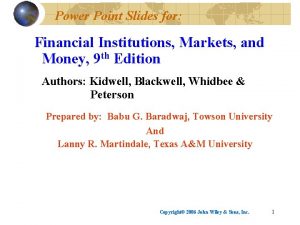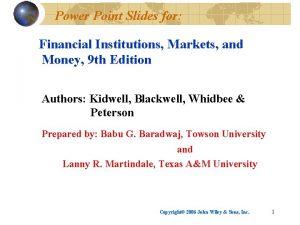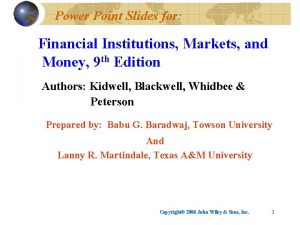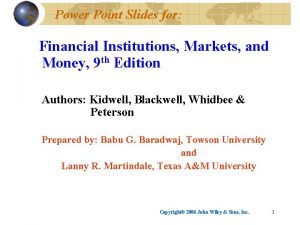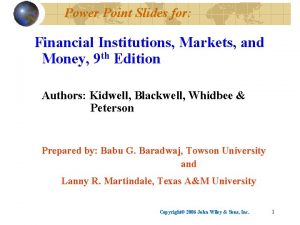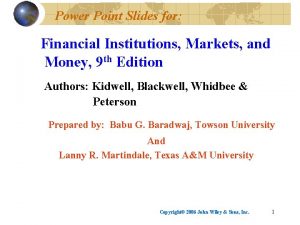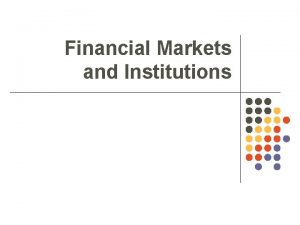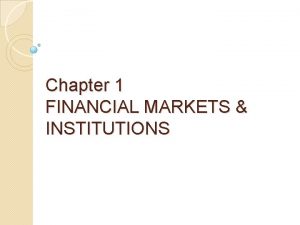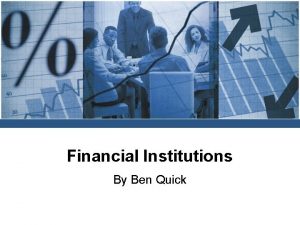Power Point Slides for Financial Markets and Institutions





























- Slides: 29

Power. Point Slides for: Financial Markets and Institutions 6 th Edition By Jeff Madura Prepared by David R. Durst The University of Akron

CHAPTER 10 Stock Offerings and Investor Monitoring

Chapter Objectives Describe the stock exchanges where stocks are traded n Analyze the process of the initial public offering of stock by a company n Be able to interpret a stock quote n Explain the institutional use of stock markets n Describe the globalization of stock markets n Copyright© 2002 Thomson Publishing. All rights reserved.

Background on Common Stock l Common stock = certificate representing equity or partial ownership in a corporation Issued in primary market by corporations that need long-term funds Stock is then traded in the secondary market, creating liquidity for investors and company evaluation for managers Copyright© 2002 Thomson Publishing. All rights reserved.

Background on Common Stock Ownership and Voting Rights l Owners of common stock vote on: u. Election of board of directors u. Authorization to issue new shares u. Amendments to corporate charter u. Other major events Many investor assign their vote to management via a proxy l Households own about half of all common stock, the rest is owned by institutional investors l Copyright© 2002 Thomson Publishing. All rights reserved.

Background on Preferred Stock Represents equity or ownership interest, but usually no voting rights n Trade voting rights for stated fixed annual dividend n Dividend paid before common if dividends are declared by board of directors n Dividend may be omitted n Cumulative provision l If common dividend paid, preferred dividend fixed l Copyright© 2002 Thomson Publishing. All rights reserved.

Public Placement of Stock n Initial public offerings (IPOs) First-time offering of shares to the public l Firm must provide information to public l u. Registration statement to SEC u. Prospectus u. Firm l is assisted by an investment banker Performance of IPOs u. Price generally rises on first day u. Longer-term performance of IPOs is poor Copyright© 2002 Thomson Publishing. All rights reserved.

Public Placement of Stock n Secondary stock offerings l n New stock issued by firm that already has shares outstanding Shelf Registration 1982 SEC rule l Allows firms to place securities without the time lag associated with registering with SEC l Copyright© 2002 Thomson Publishing. All rights reserved.

Stock Secondary Markets Organized Exchanges Execute secondary market transactions l Examples: NYSE, AMEX, Midwest, Pacific l NYSE is largest, controlling 80 percent of value of all organized exchanges l u. Must own a seat on exchange in order to trade u. Trading resembles an auction Copyright© 2002 Thomson Publishing. All rights reserved.

Stock Secondary Markets Over-the-Counter Market No trading floor or specific location l Telecommunications network l Nasdaq l u. National Association of Securities Dealers Automatic Quotations u. Thousands of small firms, plus high-tech giants l Pink sheets u. Tiny firms that do not meet requirements for NASDAQ Copyright© 2002 Thomson Publishing. All rights reserved.

Stock Secondary Markets Trend: Consolidation of stock exchanges n Market microstructure n l Specialists, floor brokers, and market-makers u. Role l of specialists Types of orders u. Market order u. Limit order u. Stop order Copyright© 2002 Thomson Publishing. All rights reserved.

Stock Secondary Markets l Changes in technology u. Online trading u. Real-time quotes u. Company information u. Electronic Communications Networks (ECNs) l Margin requirements u. Specify amount of borrowed versus amount in cash Copyright© 2002 Thomson Publishing. All rights reserved.

Stock Secondary Markets l Purchasing stock on margin u. Borrow a portion of the funds from broker u. Margin is the amount of equity an investor provide u. Magnifies returns (both good and bad) l Short sales u. Borrow stock and sell u. Repay stock loan, hopefully at a lower price u. Investor able to have potential profit from decline in stock price Copyright© 2002 Thomson Publishing. All rights reserved.

Regulation of Trading on Stock Exchanges n. Securities Act Of 1933 and 1934 n. Securities And Exchange Commission n. National Association Of Securities Dealers (NASD) n. Regulate minimum information for investor and broker/dealer business practices n. Circuit breakers Copyright© 2002 Thomson Publishing. All rights reserved.

Stock Quotation n Stock Quotation 52 -week price range (high/low and YTD% change) l Stock symbol l Dividend annualized and dividend yield l Price-earnings ratio l Volume in round lots l Previous day’s price close and net daily change l Remainders in cents, not eighths l Copyright© 2002 Thomson Publishing. All rights reserved.

Exhibit 10. 6 YTD % change Hi Lo Stock Sym DIV Yld% PE Vol 100 s Last Net Chg 110. 3 121. 88 80. 06 IBM . 56 . 6 20 71979 93. 77 11. 06 Year-to-date percentage change in stock price Highest price of the stock in this year Lowest price of the stock in this year Annual dividend paid per year Dividend yield, which represents the annual dividend as a percentage of the prevailing stock price Priceearnings ratio based on the prevailing stock price Trading volume during the previous trading day Closing stock price Name of stock Symbol Change in the stock price on the previous trading day from the close on the day before Copyright© 2002 Thomson Publishing. All rights reserved.

Stock Indexes n Dow Jones Industrial Average Price-weighted average l 30 large U. S. firms l n Standard and Poor’s (S&P) 500 Value-weighted l 500 large U. S. firms l New York Stock Exchange Indexes n Other Stock Indexes n l Amex, NASDAQ Copyright© 2002 Thomson Publishing. All rights reserved.

Stock Indexes n Investing in stock indexes Indexing l Has become very popular l u. Lower transactions costs u. Studies find that actively-managed funds do not outperform stock indexes n Examples of publicly traded stock indexes SPDRs l Diamonds l Copyright© 2002 Thomson Publishing. All rights reserved.

Stock Market Performance n Comparing stock performance to bond performance Copyright© 2002 Thomson Publishing. All rights reserved.

Investor Trading Decisions Stock value = proportional value of total company n Investor return = dividend yield + capital gain/loss n New information translated into trading decisions impacting supply/demand for shares n New equilibrium price established until new information appears n Copyright© 2002 Thomson Publishing. All rights reserved.

Exhibit 10. 8 New Favorable Information Disclosed to Investors New Unfavorable Information Disclosed to Investors Increased Valuation of Security by Investors Reduced Valuation of Security by Investors Increased Demand for Security Reduced Supply of Security for Sale Reduced Demand for Security Increased Supply of Security for Sale Increase in Equilibrium (Market) Price of Security Decrease in Equilibrium (Market) Price of Security Copyright© 2002 Thomson Publishing. All rights reserved.

Institutional Participation in Stock Markets n Program trading by institutions Simultaneously buying and selling of a portfolio of at least 15 different stocks valued at more than $1 million l Most commonly used by securities firms l Program refers to the use of computers l Impact on stock volatility l u. Often blamed for rise or fall in stock market u. Studies show that program trading does not increase volatility Copyright© 2002 Thomson Publishing. All rights reserved.

Investor Monitoring of Firms in the Stock Market n Shareholder activism u. An investor who is dissatisfied with the way managers are running a firm has three choices: Sell Do Nothing Flush! Shareholder Activism Copyright© 2002 Thomson Publishing. All rights reserved.

Investor Monitoring of Firms in the Stock Market n Communication with the firm Effort to place pressure on management l Institutional investors l u. CALPERS u. TIAA Proxy contest n Shareholder lawsuits n Copyright© 2002 Thomson Publishing. All rights reserved.

Corporate Monitoring of Firms in the Stock Market n Market for corporate control Stock price declines due to poor management l subject to possible takeover l n Barriers to market for corporate control Antitakeover amendments l Poison pills l Golden parachutes l Copyright© 2002 Thomson Publishing. All rights reserved.

Corporate Monitoring of Their Own Stock in the Stock Market n Stock repurchases Dividend alternative or undervalued stock l Excessive cash relative to +NPV investments l n Leveraged buyouts (LBO) l n If managers believe the stock price undervalued, they may buy the outstanding shares with borrowed funds Stock offerings l Signals overvalued shares Copyright© 2002 Thomson Publishing. All rights reserved.

Globalization of Stock Markets n Barriers to international stock trading have decreased Reduction in information costs l Reduction in exchange rate risk l Foreign stock offerings in the United States n International placement process n Global stock exchange characteristics n Emerging stock markets n Copyright© 2002 Thomson Publishing. All rights reserved.

Globalization of Stock Markets n Methods used to invest in foreign shares Direct purchases l American Depository Receipts (ADRs) l International mutual funds l World equity benchmark shares l Copyright© 2002 Thomson Publishing. All rights reserved.

Globalization of Stock Markets n Global diversification and integration among stock markets l Integration of markets during the 1987 crash u. All major stock markets declined, indicating the underlying cause systematically affected all markets l Integration of markets during mini-crashes u. Example: August 27, 1998 “Bloody Thursday” u. Russian financial crisis n Increased integration associated with increased financial technology, competition, and lessened government regulation Copyright© 2002 Thomson Publishing. All rights reserved.
 Financial markets and institutions chapter 1
Financial markets and institutions chapter 1 Participants of money market
Participants of money market Financial institutions and markets lecture notes ppt
Financial institutions and markets lecture notes ppt Financial markets instruments and institutions
Financial markets instruments and institutions Madura j. financial markets and institutions
Madura j. financial markets and institutions Functions of financial markets and institutions
Functions of financial markets and institutions Madura j. financial markets and institutions
Madura j. financial markets and institutions Why study financial markets and institutions
Why study financial markets and institutions Chapter 12 money and financial institutions
Chapter 12 money and financial institutions Chapter 12 money and financial institutions
Chapter 12 money and financial institutions The financial system
The financial system International financial markets and instruments
International financial markets and instruments Savers and investors role in financial markets
Savers and investors role in financial markets Difference between primary and secondary market
Difference between primary and secondary market Financial markets and the allocation of capital
Financial markets and the allocation of capital Foreign exchange and international financial markets
Foreign exchange and international financial markets Pilbeam k. finance and financial markets
Pilbeam k. finance and financial markets Keith pilbeam
Keith pilbeam Chapter 6 consumers savers and investors answer key
Chapter 6 consumers savers and investors answer key Why study money banking and financial markets
Why study money banking and financial markets Why study money banking and financial markets
Why study money banking and financial markets A small child slides down the four frictionless slides
A small child slides down the four frictionless slides A small child slides down the four frictionless slides
A small child slides down the four frictionless slides Functions of financial institutions
Functions of financial institutions Scheduled banks vs non scheduled banks
Scheduled banks vs non scheduled banks Functions of financial system
Functions of financial system Types of financial institutions
Types of financial institutions Enterprise risk management for financial institutions
Enterprise risk management for financial institutions Louisiana office of financial institutions
Louisiana office of financial institutions Accounting for financial institutions
Accounting for financial institutions



